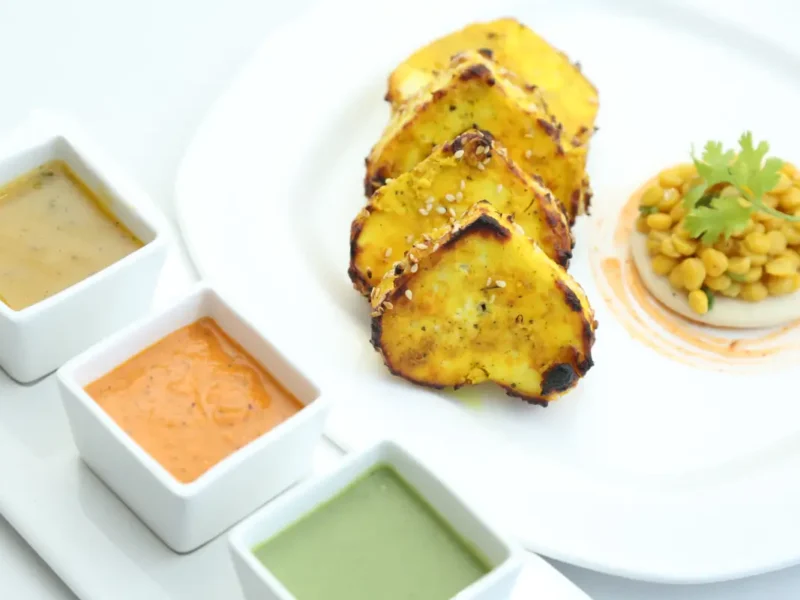
Alu Vadi
By LUKE COUTINHO
Alu Vadi is a perfect tea- time snack.
Ingredients:
6 large fresh colocasia leaves arvi/arbi/taro leaves
200 g chickpea flour
50 g rice flour
50 g sattu flour
2 tsp ground cinna
2 tsp ground Ceylon/Srilankan cinnamon
1/4 tsp caraway seeds
1 tsp ground fennel seeds
1 tsp chili powder
1/2 tsp ground cumin seeds
1 1/2 tsp salt
1 inch ginger peeled and grated
2 green chilies optional
5 tbsp fresh tamarind pulp
100 g jaggery powder
500 ml water
For the tempering
1 tbsp cold pressed coconut oil or unrefined mustard oil
1 tbsp mustard seeds
1 tsp asafoetida
2 tbsp sesame seeds
10-12 curry leaves
2 tbsp fresh coriander leaves to garnish.
Instructions:
To prepare the colocasia leaves:
– Begin by wiping the colocasia leaves.
– Clean with a damp kitchen towel.
– Clean both sides thoroughly.
– Use a sharp knife to laterally trim the thick spine that runs down the leaf.
– Simply run the knife across the stalk to flatten it so it feels flat to the touch.
– Continue this process for all of the veins that branch out from the center.
– Repeat the trimming for all the leaves.
To make the batter:
– In a large bowl, combine the chickpea flour, rice flour, sattu flour, ground cinnamon, immunity powder, ajwain, ground fennel seeds, ground cumin seeds, chili powder, and salt.
– Whisk to combine.
– Add the grated ginger, green chilli paste, tamarind and jaggery powder.
– Slowly add the water, whisking all the time to ensure a smooth paste is formed without lumps.
– Continue whisking for 5 minutes until the paste is smooth.
– Set aside for 15 minutes.
To assemble the Alu Vadi
– Organise the colocasia leaves by size.
– The assembly process will begin with the largest leaves to the smallest leaf.
– Take the largest colocasia leaf and lay it (dull side up) out on a clean, flat surface.
– Top with a large spoonful of batter.
– Use a rubber spatula, or your hands to spread the batter over the leaf.
– Take the second largest leaf and place it dull side-up in the opposite direction to the first leaf.
– It should look like a butterfly, the four corners resembling wings.
– Repeat the spreading process so that the second leaf is covered and place the next leaf in the opposite direction once again.
– Once all the five leaves are stacked, cover it finally with more batter.
– Fold one side of the leaves down to the center.
– Repeat for the other side so the leaves meet in the middle.
– It should form a rectangle.
– Cover with more batter.
– Starting from the short side, begin to form a tight roll.
– Ensure the roll is as tight as it can be without the batter squeezing out or the leaves breaking.
– Rub any remaining batter on the outside of the log to stick down any loose ends.
To steam the Alu Vadi:
– Heat up water and place the pot in a cooker.
– Grease a dish with a few drops of oil and place it in the pot.
– Place the rolls on the dish with the sealed side facing down.
– Close the lid and steam on medium heat for 15 minutes.
– Let it cool down and cut the roll into � in wide pieces.
To finish the Alu Vadi:
– Slice the cooled Alu Vadi into 1/2cm pieces using a sharp knife.
– If you prefer a lighter snack, you can eat them steamed too.
For the tampering:
– Heat the oil in a pan.
– Add the mustard seeds once they crackle, add asafoetida, sesame seeds and curry leaves.
– Arrange the Alu vadi slices in the pan and cook on both sides until golden brown and crispy all over.
– Remove from the pan and garnish with fresh coriander leaves.
– Serve warm or at room temperature with masala chai.
Important Note:
– Do not consume taro leaves as a raw vegetable or in their raw state.
– They should be soaked first in clean water and then cooked for at least 30 minutes.




